About a month ago, M. and I took a little vacation to Denver. We had been desperately in need of a non-family-centric trip, and neither of us had ever been to Colorado before. So we booked our plane tickets and then started searching for accommodations.
I was determined not to use AirBnB for our trip. We’ve used AirBnB before, with little to no issues, but there have been a lot of accusations of racism surrounding the platform itself. There’s also the possibility that AirBnB is jacking up the cost of housing in cities that are already impossible for lower-income residents to survive in.
Unfortunately, hotels, another alternative, are not the most environmentally friendly. Hotel rooms are (typically) stocked with little plastic bottles of toiletries that are changed out with each new guest, increasing the unsustainable consumption of plastic. The bottles may not be recyclable, and even if they are, who knows if the hotel actually follows through on recycling? Breakfast is usually served with single-use, nonrecyclable, noncompostable items too, like plastic coffee stirrers, plastic-coated tea bags, and packets of creamer. And I doubt the major hotel chains follow ecofriendly, low-waste practices when it comes to cleaning and laundering.
So cue the bed and breakfast (henceforth referred to as the B&B). To be honest, I’d never considered the B&B to be an attractive accommodation. I had this image of B&Bs as old-fashioned and stuffy, thanks to a whole lot of television shows and movies that seemed eager to feed me this stereotype. But when I started exploring our accommodation options, I kept seeing the name “Queen Anne Bed and Breakfast” in my search results. The Queen Anne was in our desired neighborhood, close to a lot of attractions, and in our price range. And, it billed itself as an ecofriendly business, one that uses low-waste practices, organic bedding, and organic toiletries. I was intrigued, to say the least. We took a look at their website and realized that a room with a hot tub in the Queen Anne B&B was the same price as a regular hotel room in the same area! We were sold.
It was easy to find the Queen Anne once we landed in Denver. The B&B is located in a quaint up-and-coming neighborhood an easy bus ride away from Union Station. The Queen Anne actually comprises two buildings, one of which hosts the dining nook and common area. As we walked up to the door of the main building, we marveled at the beautiful flowers lining the pathway. I had never seen so many butterflies in one place in my life, which (to me) was a good sign of a healthy ecosystem. (M. later informed me that the ridiculous number of butterflies was due to migration patterns. Still awesome.)
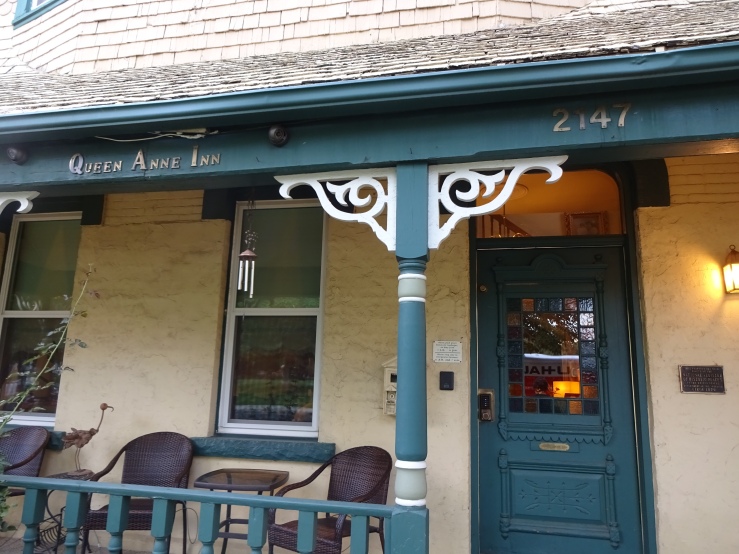
Once we had our fill gawking at the flowers, we rang the doorbell and the innkeeper came out to greet us. She was extremely friendly, and gave us a little tour of the common areas. There was even a beautiful backyard for relaxing in. She pointed out the herbs, peppers, and leafy greens that were growing around the house/B&B, and mentioned that the B&B kitchen often harvests from the garden for their daily breakfast preparations. My green, food-loving heart soared upon hearing this.
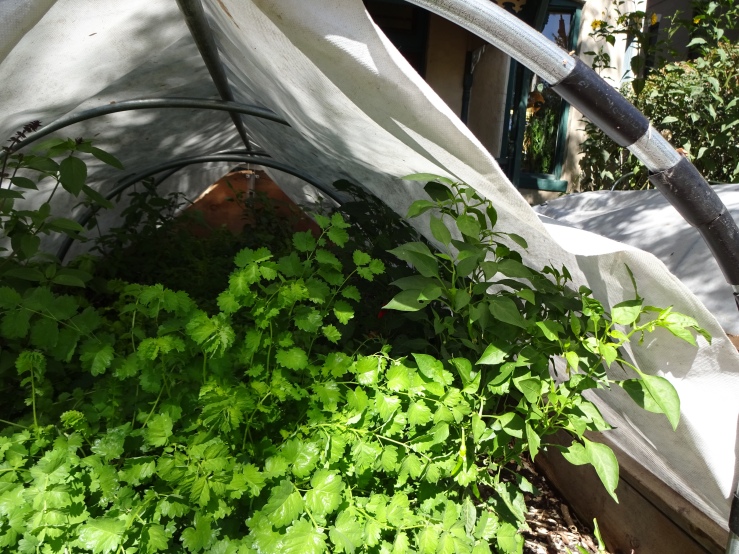
After the tour, we set out to explore our room: Gallery Suite #2. It’s called the gallery suite because the walls are decorated with pieces from local artists. Gallery Suite #2 is one of the most expensive rooms in the Queen Anne, but we wanted to treat ourselves (although it’s still affordable compared to some hotels out there).
The bedroom area had an exposed brick wall with an inset stained-glass window, a vanity area (with desk, lamp, and mirror), a record player, an armchair, and a bench by the window. The bed was plush and cozy, and according to the Queen Anne’s website all of their mattresses are made with recycled metal coils and sustainable green tea insulation foam. Their bedding is supposed to be 100% organic cotton, “undyed and unbleached.” However, the pillowcases and the duvet cover are certainly not undyed (they are gray, as you’ll notice from the photo), so I’m assuming that by “bedding,” the Queen Anne’s website is referring to the actual sheets (which looked undyed to me). When I took a closer look at the gray pillows, I did notice one of the tags stated that the material was polyester. Unfortunately, I forgot to investigate the fabric tag on the sheets themselves.
The bathroom was outfitted with a cast-iron tub and the usual toiletries (all from companies that tout themselves as sustainable). The shower gel, conditioner, and shampoo were all located in a large refillable dispenser, which is meant to reduce waste by allowing the B&B to continue refilling the dispenser from bulk containers rather than buying and replacing smaller bottles. (If you look closely at the photo below, you can see the dispenser reflected in the mirror.) There was also a sign on the bathroom wall detailing the B&B’s ecofriendly policy of changing linens “between guests or on request only (towels on floor or in tub).” I really like this policy because it reduces excessive laundering (and therefore reduces excessive water consumption). If you’re staying at the B&B for more than one night, you really don’t need to have a new batch of freshly laundered towels brought to you every day.
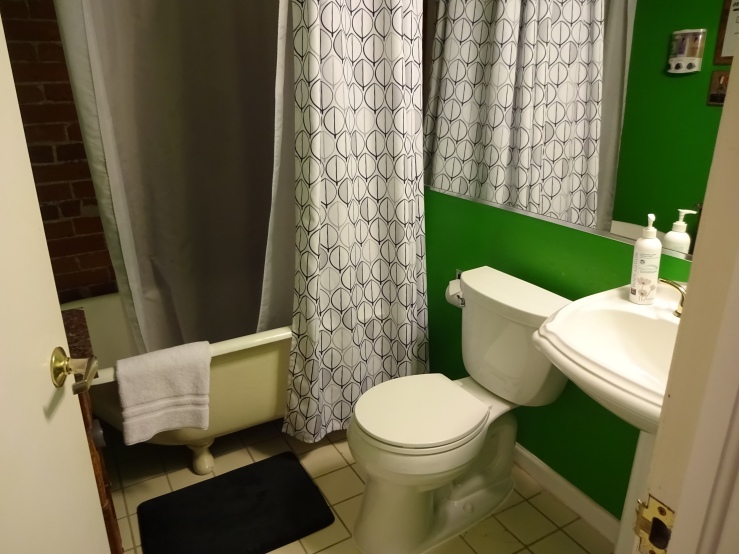
Now, to the hot tub area. The hot tub was located at the end of a small hallway. There was a door separating the bedroom from the hot tub room, and the hot tub room also had a door leading out to the B&B’s backyard, in case we wanted to have some fresh air wafting in while we were “tubbing.” We felt quite spoiled. It even had multi-colored lights!
Once we were done tubbing, we decided to check out the Queen Anne’s “happy hour.” The happy hour is a little meet and greet that is hosted in the B&B’s common area every day from 5:30 p.m. to 7:00 p.m. Local wines and local cheeses are served, and the guests can mingle as they choose. M. and I were happy to sample the wine, which was delicious, and we took a few too many servings of cheese and crackers. . . .We didn’t mingle much, because we are a bit introverted, but the other guests were friendly and seemed to be enjoying their stays as well.
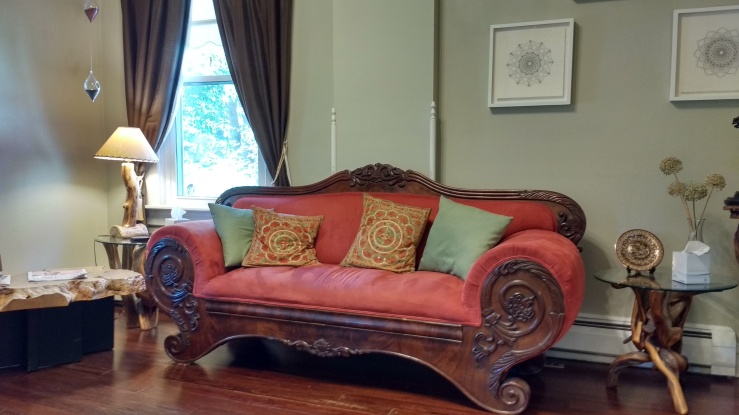
After a good night’s sleep, M. and I woke up early the next day because we were curious what the B&B’s homemade breakfast would be like. We were not disappointed. On the menu that day were homemade waffles with blueberry compote. Oh, it was so delicious.
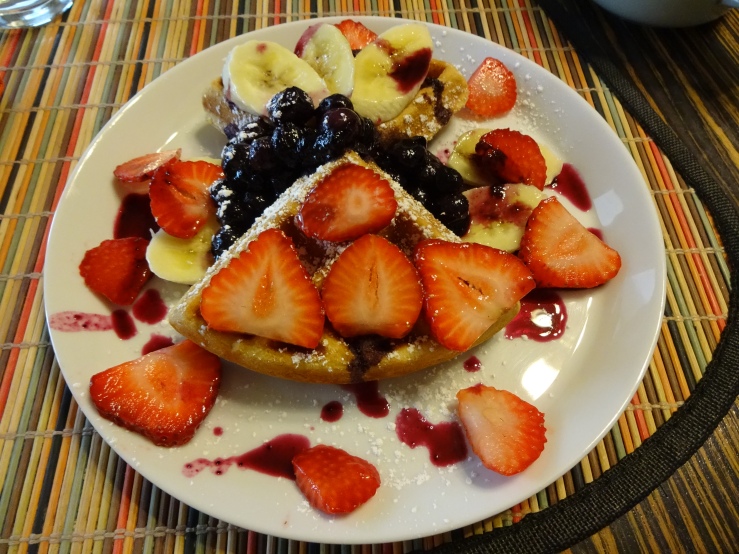
The breakfast was served on ceramic plates (reusable!), and we were each provided with a ceramic mug for coffee or tea and a glass for water or orange juice. The coffee was from Novo, a local supplier. There was also tea (my caffeine fix of choice). The tea was supplied by Mighty Leaf, and according to the label on the box the sachets are compostable, but unfortunately each sachet was wrapped in what appeared to be a plastic bag. 😦 Every other bit of the breakfast was wonderful though, and M. and I made a pact with each other to continue waking up early each day of our stay, since we didn’t want to miss the other breakfasts!
On the second day, we had the great fortune of having breakfast cooked for us by the owner himself! He made us a mushroom and spinach omelette with cherry tomatoes and guacamole, garnished with chives from the B&B’s garden. Again, so good!
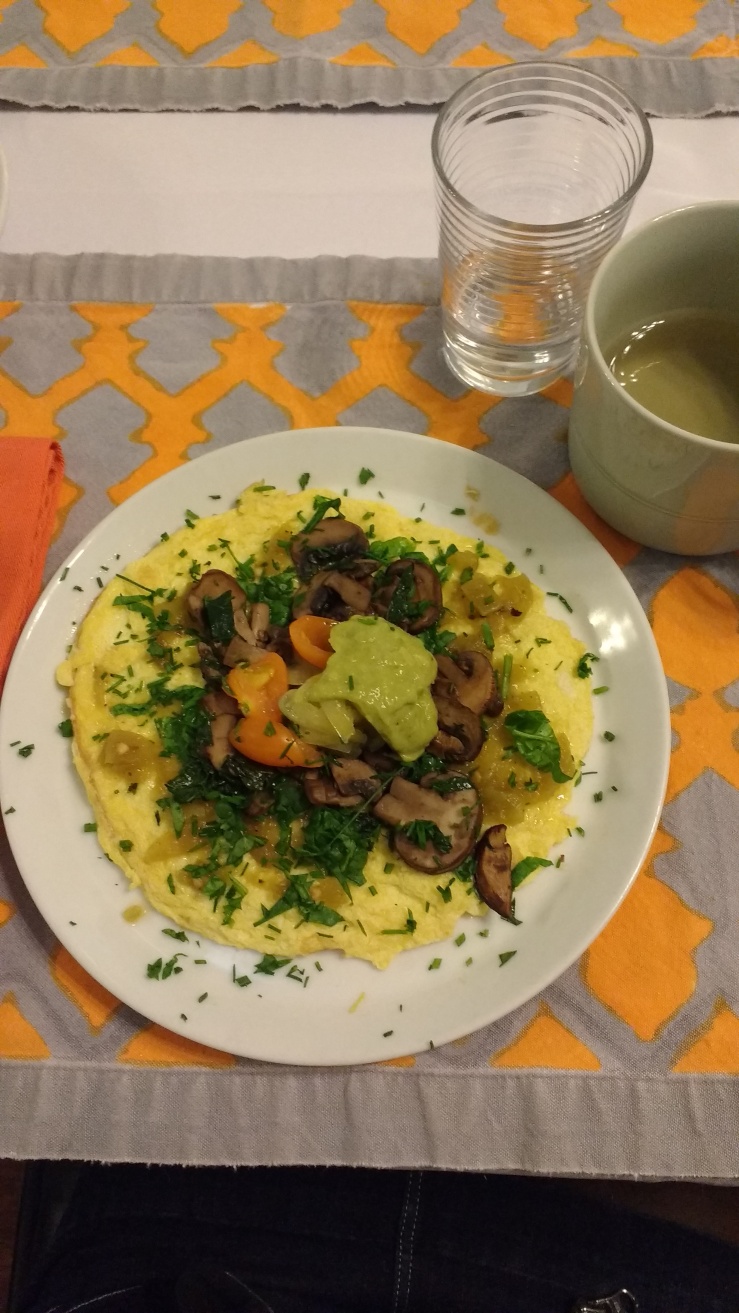
We also had the opportunity to chat with the owner for a little bit once he was done in the kitchen. We learned that he has owned the Queen Anne for about eight years now, and that he used to be a professional chef (no wonder the breakfasts are so good)! We also met his parents, who happened to be visiting him and were helping him out. It was great to see behind the scenes and get glimpses of the owner and his family; I got the sense that the owner truly cares about his guests. Not only was he cooking for everyone, he was happy to take the time to give M. and me a long list of recommendations for where to go in Denver after we expressed that we weren’t sure what to do that day.
On our third and last day, the Queen Anne kitchen continued to delight. The featured breakfast that day was scrambled eggs with chives from the garden and paneer cheese, a fresh-fruit cup (served in a ceramic ramekin), a green chutney, and Indian flatbread (possibly chapati). I was pained knowing that that we would be leaving that night. Oh, how I miss those breakfasts now.
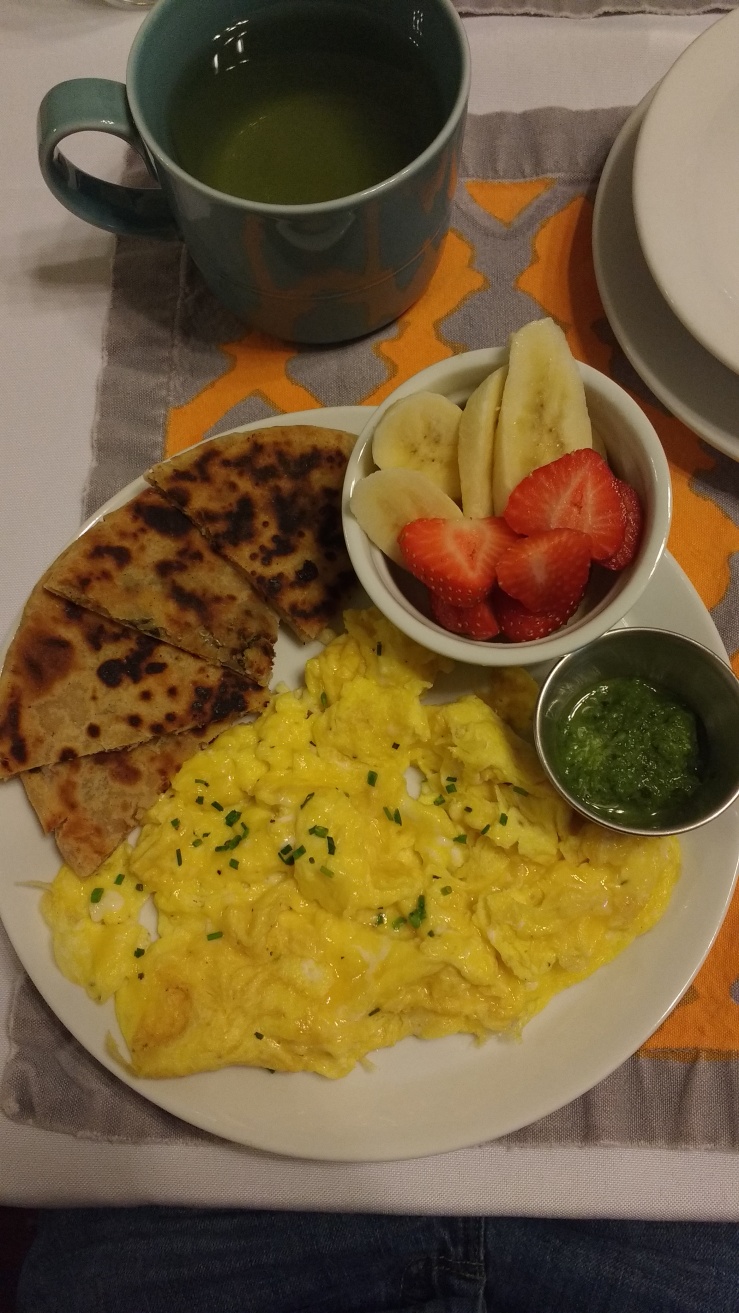
Overall, we had a wonderful time at the Queen Anne, and I can’t wait to go back. In terms of our stay and enjoyment, I would give the Queen Anne Bed & Breakfast 5 out of 5 gold stars. Our room was cozy and comfortable, the hot tub was a delight, and the innkeepers and the owner were all extremely friendly and accommodating. Not to mention, the food was excellent!
But, how does the Queen Anne’s sustainability stack up? I think it’s clear that the Queen Anne is doing its best to be sustainably and ethically run. By using bulk soap dispensers, the B&B avoids excessive plastic consumption. By laundering only on request/between guests, the B&B avoids excessive water consumption. (According to the B&B’s website, the shower heads are also low flow, which saves even more water.) By using local ingredients in their breakfasts and happy hours, including ingredients from their own gardens, the B&B lowers its greenhouse gas emissions since its suppliers don’t have to ship or transport items very far. (Keeping a garden also aids local fauna [like bees and butterflies].) And by using organic cotton sheets and sustainably made mattresses, the B&B both lowers its carbon footprint and supports sustainable manufacturing. Last, but not least, the buildings that make up the Queen Anne Bed and Breakfast are each over a century old; repurposing and preserving old buildings instead of tearing them down can be more sustainable because you avoid using up energy to tear the building down and you avoid releasing greenhouse gases in the production of new materials for raising a new structure.
However, there are a couple of areas where the Queen Anne could improve. The gray pillowcases and gray duvet cover seemed to be made of polyester, which is certainly not sustainable. At the very least, I would suggest switching to recycled polyester for those parts of the bedding. I would also suggest finding a different tea supplier, one that doesn’t keep its tea sachets in noncompostable plastic bags. And, last but not least, while M. and I thoroughly enjoyed the hot tub, hot tubs are not very ecofriendly. They typically use chlorine to clean the water, and they consume a lot of energy. Unfortunately, I can see why having a hot tub in the B&B would be lucrative (it certainly attracted M. and me to the venue), so my best suggestion would be to try to replace their current hot tub with a more energy-efficient one or to retrofit it to be more energy efficient. (To be completely honest, I’m not sure what model hot tub the Queen Anne currently uses, so perhaps it is already the most energy efficient that it can be).
Overall, the Queen Anne is still much more environmentally friendly than a traditional hotel establishment. The owner and innkeepers clearly have a mind for sustainability, and I would much rather support a small business where the owner has a closer and deeper connection with the clientele and has an honest consideration for the environment. Additionally, the owner is a person of color, and I believe it is very important to help lift up businesses owned by people of color because my country (the United States) clearly has a problem distributing power and wealth equally—if the government won’t fight for equality for “minority” groups, then it’s up to citizens and consumers to do so with their voices and their dollars.
So, here’s my final verdict: using the Green Stars Project‘s system, I’m going to give the Queen Anne 4.5 out of 5 green stars! The Queen Anne could improve a little bit in two or three small areas, but overall it is doing a great job with sustainability. The owner has his heart in the right place, and I’m sure he’ll keep making strides forward. Staying at the Queen Anne also helps avoid the ethical and sustainability pitfalls of traditional hotels and AirBnBs, and supporting a small, local business that supports other small, local businesses keeps money and power in the hands of people who actually want to change our world for the better.
If you’re ever in Denver and looking for a sustainably and ethically run place to stay, go to the Queen Anne Bed & Breakfast!

❤ S. (a.k.a. AMisplacedPen)
A quick acknowledgment: This review does not consider pricing much at all, partially because that wasn’t the #1 most important factor for M. and I when we were selecting accommodations. M. and I are certainly fortunate to be able to be picky with our choice of venue, and I do not intend to shame anyone who uses AirBnB or hotels (or doesn’t travel at all) if those are your only financially viable options.
Disclaimer: I was not compensated in any way to write about any organizations or businesses that I have mentioned. This post expresses my honest opinions.






Brava! 👏👏👏💚💚💚
I’ll be announcing winner(s) in about a week!
LikeLiked by 1 person
I love the detail – you went to a huge effort. I’ve only reviewed a handful of hotels but when I did, I considered many of the same factors that you looked at (like toiletries, tea and coffee supplier, energy use, food, etc.).
Here’s a Green Stars review of Hotel Isaacs in Cork, Ireland where I also talk about toiletries in refillable dispensers! https://www.tripadvisor.com/ShowUserReviews-g186600-d218071-r466158339-Hotel_Isaacs_Cork-Cork_County_Cork.html
I’ll definitely consider the Queen Anne next time I visit Denver. Also – the food looks amazing! Glad you had a nice break!
LikeLiked by 1 person
Thanks! 🙂 I thought I missed the deadline for your contest, but I’m certainly happy to be considered! And the food was amazing indeed. 😀
LikeLiked by 1 person
You won the Green Stars Project competition! I sent you a couple of emails – do you get them?
Congrats!
LikeLike
[…] from A Misplaced Pen wrote a review of the Queen Ann B&B in Denver, Colorado. She looked at many factors when considering her rating, including food, […]
LikeLike
[…] you missed part 1 of my discussion of sustainable tourism, check it out here. In it I detail my considerations regarding choice of accommodation in Denver. Now, on to the […]
LikeLike